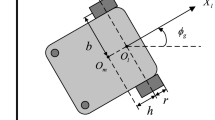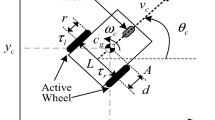Abstract
This paper addresses the problem of robust motion control of a Differentially Driven Wheeled Mobile Robot (DWMR). Using the fact that DWMRs are differentially flat systems, the motion control design is relatively simplified by defining the desired motions of the robot in the flat output space of the system. The accurate and the robust trajectories tracking are provided firstly, by imposing the sliding manifold from the flat output space of the system. Secondly, an adaptive gain discontinuous control law -adaptive sliding mode controller- is introduced to drive to zero in finite time such sliding manifold, despite model uncertainties and external disturbances. The system stability is proven using the Lyapunov theory. Compared with classical Feedback control algorithms and using the laboratory test prototype, Pioneer 3DX, simulation and practical tests are presented to illustrate the performances of the proposed approach in the presence of unknown external disturbances.
Similar content being viewed by others
References
S. G. Tzafestas, Introduction to Mobile Robot Control, Elsevier, Inc, 2014.
L. Zhang, C. C. Lim, Y. Chen, and H. R. Karimi, “Tracking mobile robot in indoor wireless sensor networks,” Mathematical Problems in Engineering, Hindawi Publishing Corporation, vol. 2014, 2014.
B. S. Park and S. J. Yoo, “Adaptive leader-follower formation control of mobile robots with unknown skidding and slipping effects,” International Journal of Control, Automation, and Systems, vol.13, pp. 587–594, June 2015.
Y. Tang, X. Xing, H. R. Karimi, L. Kocarev, and J. Kurths, “Tracking control of networked multi-agent systems under new characterizations of impulses and its applications in robotic systems,” IEEE Trans. on Industrial Electronics, vol. 63, pp. 1299–1307, June 2015.
G. Campion and W. Chung, “Wheeled robots,” Springer Handbook of Robotics, pp. 391–410, Springer, Berlin, Heidelberg, 2008.
R. P. M. Chan, K. A. Stol, and C. R. Halkyard, “Review of modelling and control of two-wheeled robots,” ScienceDirect, Annual Reviews in Control, vol. 37, pp 89–103, 2013.
G. Oriolo, A. D. Luca, and M. Vendittelli, “WMR control via dynamic feedback linearization: design, implementation, and experimental validation,” IEEE Trans. on Control Systems Technology, vol. 10, no. 6, November 2002.
M. Fliess, J. Lévine, P. Martin, and P. Rouchon, “On differentially flat nonlinear system,” Elsevier, IFAC Proceedings Volumes, vol. 25, no. 13, pp. 159–163, June 1992.
M. Fliess, J. Lévine, P. Martin, and P. Rouchon, “Flatness and defect of nonlinear systems: introductory, theory and examples,” International Journal of Control, vol. 61, pp. 1327–1361, 1995.
V. Hagenmeyer and E. Delaleau, “Robustness analysis with respect to exogenous perturbations for flatness-based exact feedforward linearization,” IEEE Trans. on Automatic and Control, vol. 55, no. 3, pp. 727–731, March 2010.
A. L. Juarez, J. C. Romero, and H. S. Ramirez, “Trajectory tracking control of a mobile robot through a flatness-based exact feedforward linearization scheme,” Journal of Dynamic Systems, Measurement, and Control, vol. 137, May 2015.
E. Y. Veslin, J. Slama, M. S. Dutra, and O. Lengerke, “Motion planning on mobile robots using differential flatness,” IEEE Latin America Transactions, vol. 9, no. 7, pp. 1006–1011, December 2011.
R. Walambe, N. Agarwal, S. Kale, and V. Joshi, “Optimal trajectory generation for car-type mobile robot using spline interpolation,” IFAC-PapersOnLine, vol. 49, pp. 601–606, Elsevier, 2016.
J. C. Ryu and S. K. Agrawal, “Planning and control of under-actuated mobile manipulators using differential flatness,” Autonomous Robot, vol. 29, pp. 35–52, Springer, April 2010.
J. J. Slotine and W. Li, Applied Nonlinear Control, Prentice-Hall, New-Jersey, 1991.
H. Wang, H. R. Karimi, P. X Liu, and H. Yang, “Adaptive neural control of nonlinear systems with unknown control directions and input dead-zone,” IEEE Trans. on Systems, Man, and Cybernetics: Systems, vol. PP, no. 99, May 2017.
V. Utkin, “Variable structure systems with sliding modes,” IEEE Trans on Automatic Control, vol. 22, no. 2, April 1977.
V. Utkin, J. Guldner, and J. Shi, Sliding Mode Control in Electro-mechanical Systems, CRC Press, 2009.
A. Levant, “Sliding order and sliding accuracy in sliding mode control,” International Journal of Control, vol. 58, no. 6, pp.1247–1263, 1993.
A. Levant, “Higher-order sliding modes, differentiation and output-feedback control,” International Journal of Control, vol. 76, pp. 924–941, 2003.
W. Khalil and E. Dombre, Modeling Identification and Control of Robots, Kogan Page Science Paper Edition, United Kingdom, 2002.
P. Martin, R. Murray, and P. Rouchon, Flat Systems, hal-00472051, 1997.
A. Levant, “Robust exact differentiation via sliding mode technique,” Automatica, vol. 34, no. 3, pp. 379–384, Elsevier Science, 1998.
K. R. Simba, N. Uchiyama, and S. Sano, “Real-time smooth trajectory generation for nonholonomic mobile robots using Bézier curves,” Robotics and Computer-Integrated Manufacturing, vol. 41, pp. 31–42, October 2016.
C. P. Tang, P. T. Miller, V. N. Krovi, J. C. Ryu, and S. K. Agrawal, “Differential-flatness-based planning and control of a wheeled mobile manipulator-theory and experiment,” IEEE/ASME Trans. on Mechatronics, vol. 16, no. 4, pp. 768–773, August 2011.
B. Siciliano, L. Sciavicco, L. Villani, and G. Oriolo, Robotics: Modeling, Planning and Control, Springer-Verlag, London, 2009.
Author information
Authors and Affiliations
Corresponding author
Additional information
Recommended by Associate Editor Kyoungchul Kong under the direction of Editor Hamid Reza Karimi.
Mabrouk Boubezoula was born in 1981 Setif, Algeria. He received his engineer and magister degree from Ferhat Abbas Setif1 university, in 2004 and 2008, respectively. Since 2006 he is with Intellegent Systems Laboratory (LSI), Ferhat Abbas Setif1 University. His research interests are: mobile robot control, mobile manipulator, fuzzy logic control and automation control.
Abdelouahab Hassam was born in Setif, Algeria, in 1958. He received the B.Sc. degree in Electronics Engineering, in 1983, from the National Polytechnic School of Algiers (ENPA), Algeria, in 2007, he received his Doctorat degree from University of Setif, Algeria, where he is a Professor in the Electronics Engineering Department. He carried out research work in fields related to robotics, information theory, signal processing, and sensors.
Oussama Boutalbi was born in 1988 Setif, Algeria. He received engineer and magister degree from Ferhat Abbas Setif1 University, in 2010 and 2014, respectively. Since 2013 he is with Intelegent Systems Laboratory (LSI), Ferhat Abbas Setif1 University. His research interests are: the motion planning and tracking control design of autonomous robot systems and robust control design for nonlinear systems.
Rights and permissions
About this article
Cite this article
Boubezoula, M., Hassam, A. & Boutalbi, O. Robust-flatness Controller Design for a Differentially Driven Wheeled Mobile Robot. Int. J. Control Autom. Syst. 16, 1895–1904 (2018). https://doi.org/10.1007/s12555-017-0408-4
Received:
Revised:
Accepted:
Published:
Issue Date:
DOI: https://doi.org/10.1007/s12555-017-0408-4




